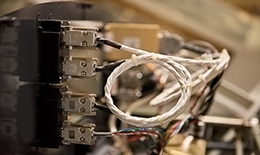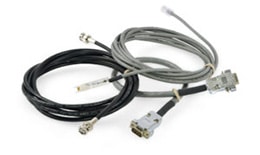

Contact Cables Unlimited Sales Department for any legacy network application needs and network configuration help
In theory, any baud rate transfer is possible; however, 19.2 bits were the most common.
Existing communication infrastructure still uses the RS-232, RS-422, and RS-485 interface, though its popularity is quickly passing.
Serial data cables were required to connect equipment at the remote end. These cables take a variety of physical forms as well as the number of pinouts required.
High-density is another DB style, which looks like a standard DB connector, using three rows instead of two. These cables and connectors are used primarily in video cards and monitors. Micro-DB is another style making up the interface.
Commonly known as half-pitch connectors, applications such as SCSI are the primary application. MD50 is one of the popular connection types.
Legacy data systems utilize different levels of connector handshaking when using the RS232 standard. Four copper wire types are in the RS-232 cable interface: data, control, timing, and ground.
RS232 was designed so telephone wires could be used to transmit data over the system.
Cables Unlimited and DB Connectors
Cables Unlimited manufactures high quality DB9, DB25, DB37, and DB50 cables. Our DB style cables are made in the United States with standard or customized pinouts. We offer these in a variety of jacket styles for either indoor or outdoor configurations.
Voltage levels are a significant part of the RS232 interface. Signals between -3V and -25V represent a logic 1, while +3V and +25V correspond to a Logic 0. Control signals are ON if positive and OFF if negative. Data is sent serially one bit after the next.
Serial data transmissions must be synchronized and start with a logic 0 bit, followed by the data itself. A parity bit is sent to ensure the data is correct. Then a stop bit finishes off the transmission.
Data on RS232 devices are dispatched using the ASCII code or American Standard Code for Information Interchange. Other codes include Murray and EBCDIC.
DB Style DB9 Connectors and Cables:
Originally dubbed as the “D-subminiature” style, these cables operate in serial and parallel computing devices, with the RS232 connector interface. DB style connectors are equivalent to the number of pins they feature.
Our DB9 connectors have two rows of 9 pins, with a shell size corresponding to the total number of pins or sockets. Accordingly, a DB9 signifies a 9-position shell size and 9-position contact layout. A significant number of applications use the RS-232 port.
All our DB9 male serial ports are configured for full-duplex data transfer.
Cables Unlimited and the DB25:
Any of our cables, configured with a DB25 connector at one end and eight balanced jacks at the other, exhibit significant boosts in audio quality.
Originally, serial data transmission and the DB25 port were used to connect printers. Hence, the “Printer Port.”
Any RS-232 or SCSI device can use Our DB25 serial gateways. Parallel ports with D-Sub connectors are commonly referred to as IEEE-1294 Type A. Legacy parallel ports typically feature a single DB25 female connection.
Occasionally, our male serial DB25 ports are used instead of the DB9 connector. Technicians can use the female DB25 connectors for older Apple computers and SCSI expansion cards.
Any of our DB9 or DB25 connectors transmit serial data using the RS-232 standard.
DB37:
The RS-449 standard began the race to high-speed data transmission, superseding the slower RS-232.
DB37 connectors from Cables Unlimited are the communications interface for the RS-449 standard. Link management was implemented with the RS-423, single-ended interface.
Connectors from Cables Unlimited have far-reaching applications around the world. Environments with heavy electromagnetic interference use our DB37 cable and connectors; because they offer good noise immunity.
Cisco networking equipment, security control systems, video hardware, and satellite antennas rely on the DB37 cables and connectors.
DB50 Connectors:
Our serial DB50, D-Sub Connectors conform to every available commercial industry standard. We offer male and female adapters for every application your legacy network requires.
Applications for our DB50 cables and connectors include:
Networks; data and video
Device Management
Instrument control
Serial data Transmission
DB style connectors and accompanying cables are valuable resources in a world wrapped in blindingly fast digital networks. Standards such as the RS-232 and RS-499 have been continually updated as technologies continue to evolve.
Cables Unlimited remains focused on our customer’s past, present, and future needs.




